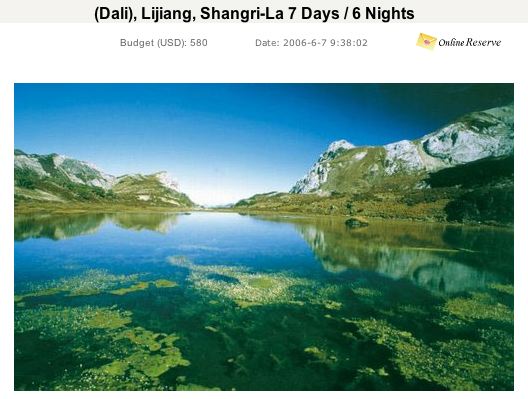a ticket to Shangri La
We’ve got a wonderful new contributor at Virtual China — Kathrine Hoersted, Danish social anthropologist. Kathrine is going to be exploring non-Han (something like 90% of mainland China identifies as belonging to the Han group) Chinese virtual places and spaces. Think Tibetan, Mongolian, Uighur, Naxi, and more. We’re trying to map out where non-Han online activity and expression shows up, and how much of it is created by non-Han Chinese themselves. Kathrine starts by trying to find Shangri La –Lyn
It used to be an imagined place, but now it has been rediscovered as a physical location on earth, and is even promoted in the virtual world.
To the Tibetans “Shamba La” is a mythical imagined place where people are said to live peacefully for all eternity. “Shangri La” entered the Western imagination via James Hilton‘s bestselling 1933 novel Lost Horizon. In the fictional book he described a physical place in Tibet which he called Shangri La, where people of all religions and ethnicities coexist in happy harmony and live to be hundreds of years old.
In today’s cash-driven Chinese tourist market, competitive discussions have arisen between counties in Sichuan and Yunnan about where Shangri La was really situated. Many arguments and intents to prove the exact location have been based on descriptions from Hilton’s fictional novel. Recently, the local government in Zhongdian town was given official permission by the Chinese authorities to rename their town and County Shangri La. So the modern Shangri La now exists in The Tibetan Autonomous Prefecture, Dechen (Diqing in Chinese) located in the northern part of China’s Yunnan Province.
Zhongdian itself is the subject of many an English-language travel site and blog, 6,550 images via Google, over 1000 images at Flickr. Shangri La can be taken in on a number of Chinese-operated tours. Local Tibetans, however, continue to refer to this location as Gyalthang.

Nice to read about.
good site.
go ahead.
will look for it.
If you’re looking for Shangri-La I wrote an article about the competing claims some time ago:
http://www.chinadaily.com.cn/english/doc/2005-09/24/content_480493.htm
It’s based on my travels in the area, written up at the blog In the Footsteps of Joseph Rock (http://drjosephrock.blogspot.com)
I live in Zhongdian. The claim that local Tibetans still refer to the location as Gyalthang is misleading. The name has re-gained popularity, but pretty much everybody still calls the place Zhongdian.
Eye on Lesbian Shanghai: Welcome to Lala Land
No, Shanghaiist isn’t talking about xanadu or China’s “rediscovered” Shangri-La. And, we are definitely not referring to the Tongren Lu establishment that just opened (no offense, but Tongren sucks!). Anyone who reads Danwei (or China Daily) knows that…
Nice Picture
Good Website